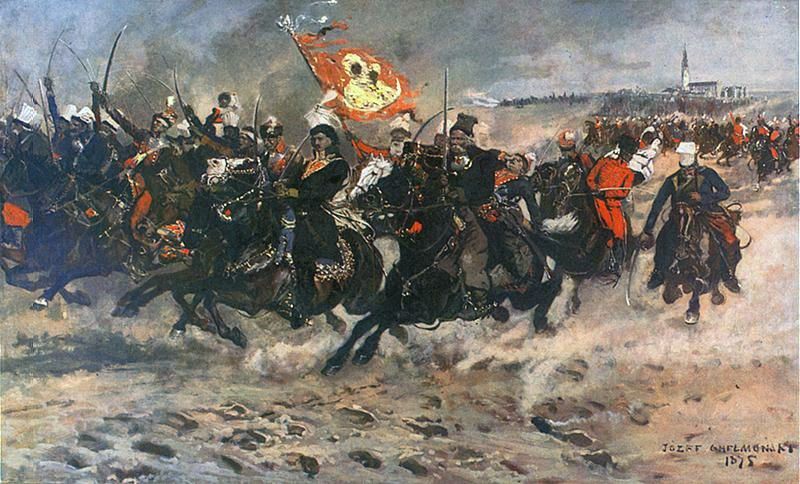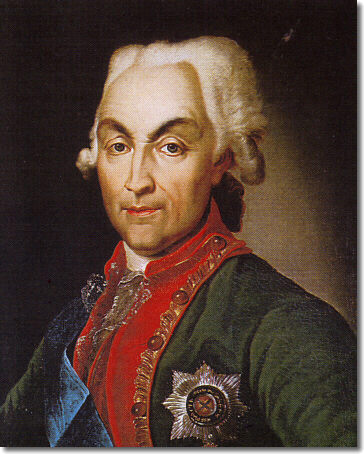|
Celestyn Czaplic
Celestyn Czaplic (1723–1804) of the Kierdeja coat of arms was a Polish–Lithuanian szlachcic, politician, writer and a poet. Remembered for his humorous poetry and impeccable moral character, he was a deputy to numerous Sejms of the Polish–Lithuanian Commonwealth, and a marshal of the Sejm of 1766. He held the offices of podczaszy, podkomorzy, and finally, from 1773, of the Master of the Hunt of the Crown. He was the recipient of the Order of Saint Stanislaus and the Order of the White Eagle. Biography He was born on 6 April 1723 in Volhynia to the noble Czaplic family. His father Ignaczy Czaplic, was a podstoli of Kiev in the Kiev Voivodeship. He attended schools in Volhynia, and spent time at the court of the magnate and prince Antoni Lubomirski. Later, he became an ally of the Czartoryski family. He became the podczaszy of Kiev in 1746. He was elected a deputy to the Crown Tribunal and the Sejms of 1752, 1754, 1758, 1766 and 1767–68 (the infamous Repnin Sejm). The ... [...More Info...] [...Related Items...] OR: [Wikipedia] [Google] [Baidu] |
Kierdeja Coat Of Arms
Kierdeja - is a Polish coat of arms. It was used by several szlachta families in the times of the Polish–Lithuanian Commonwealth. History Blazon Notable bearers Notable bearers of this coat of arms include: * General Eufemiusz Czaplic * Jan Czaplic (Kiev castellan, d. 1604) * Aleksander Czaplic-Szpanowski ( Polish Arian connected with the Kisielin community (Volhynia), expelled from Poland in 1660, d. 1664) * Józef Czaplic (Orthodox bishop of Lutsk, d. 1654) * Celestyn Czaplic ( Master of the Hunt of the Crown, Marshal of Polish Sejm, d. 1804) See also * Polish heraldry * Heraldry * Coat of arms A coat of arms is a heraldry, heraldic communication design, visual design on an escutcheon (heraldry), escutcheon (i.e., shield), surcoat, or tabard (the latter two being outer garments). The coat of arms on an escutcheon forms the central ele ... Polish coats of arms {{poland-heraldry-stub ... [...More Info...] [...Related Items...] OR: [Wikipedia] [Google] [Baidu] |
Permanent Council
The Permanent Council () was the highest administrative authority in the Polish–Lithuanian Commonwealth between 1775 and 1789 and the first modern executive government in Europe. As is still typically the case in contemporary parliamentary politics, the members of the Council were selected from the parliament or ''Sejm'' of the Commonwealth. Even though it exerted some constructive influence in Polish politics and government, because of its unpopularity during the Partitions period, in some Polish texts it was dubbed as ''Zdrada Nieustająca'' - Permanent Betrayal. History The establishment of an institution of permanent council, an early form of executive government in the late years of the Polish–Lithuanian Commonwealth, was originally recommended by the political reformer Stanisław Konarski.Józef Andrzej Gierowski – ''Historia Polski 1764-1864'' (History of Poland 1764-1864), Państwowe Wydawnictwo Naukowe (Polish Scientific Publishers PWN), Warszawa 1986, , p. 60-74 ... [...More Info...] [...Related Items...] OR: [Wikipedia] [Google] [Baidu] |
Bar Confederation
The Bar Confederation ( pl, Konfederacja barska; 1768–1772) was an association of Polish nobles (szlachta) formed at the fortress of Bar in Podolia (now part of Ukraine) in 1768 to defend the internal and external independence of the Polish–Lithuanian Commonwealth against Russian influence and against King Stanislaus II Augustus with Polish reformers, who were attempting to limit the power of the Commonwealth's wealthy magnates. The founders of the Bar Confederation included the magnates Adam Stanisław Krasiński, Bishop of Kamieniec, Karol Stanisław Radziwiłł, Casimir Pulaski, his father and brothers and Michał Krasiński. Its creation led to a civil war and contributed to the First Partition of the Polish–Lithuanian Commonwealth. Maurice Benyovszky was the best known European Bar Confederation volunteer, supported by Roman Catholic France and Austria. Some historians consider the Bar Confederation the first Polish uprising. Background Abroad At the end ... [...More Info...] [...Related Items...] OR: [Wikipedia] [Google] [Baidu] |
Radom Confederation
Radom Confederation ( pl, Konfederacja radomska, lt, Radomo konfederacija) was a konfederacja of nobility (''szlachta'') in the Polish–Lithuanian Commonwealth formed in Radom on 23 June 1767 to prevent reforms and defend the ''Golden Liberties''. It was formed by Russian envoy to Poland Nicholas Repnin and backed by the Russian Imperial Army Aleksander Kraushar, Książę Repnin i Polska, Warsaw 1900 t. I , p. 288-317. as a response of Catholic nobility to the earlier Protestant confederations of Slutzk and Toruń, approximately 74,000 nobles declared their support for Radom Confederation. The marshal of the confederation was Karol Stanisław "Panie Kochanku" Radziwiłł, another leader was the primate of Poland, Gabriel Podoski, but in fact the real leader was Russian ambassador Nicholas Repnin, who was also responsible for forming the Protestant and Orthodox confederations. On his insistence the Confederates had to make peace with Polish king, pro-Russian Stanisław August Poni ... [...More Info...] [...Related Items...] OR: [Wikipedia] [Google] [Baidu] |
Volhynian Voivodeship (1569–1795)
pl, Województwo wołyńskie uk, Волинське воєводство , subdivision = Voivodeship , nation = Lithuania (1566–1569) and then Poland (1569–1795) , year_start = 1566 , event1 = To Polish Crown , date_event1 = 1569 , event_end = Annexed by Russia , year_end = 1795 , date_end = 24 October , p1 = Grand Duchy of Lithuania , image_p1 = , s1 = Volhynian Governorate , image_s1 = , image_coat = Herbarz Kaspra Niesieckiego Волынское.svg , image_map = RON województwo wołyńskie map.svg , image_map_caption = The Volhynian Voivodeship (red) in the Polish–Lithuanian Commonwealth, 1635 , capital = Lutsk ( pl, Łuck) , stat_area1 = 38324 , stat_year1 = , stat_pop1 = , political_subdiv ... [...More Info...] [...Related Items...] OR: [Wikipedia] [Google] [Baidu] |
Łuck
Lutsk ( uk, Луцьк, translit=Lutsk}, ; pl, Łuck ; yi, לוצק, Lutzk) is a city on the Styr River in northwestern Ukraine. It is the Capital city, administrative center of the Volyn Oblast (oblast, province) and the administrative center of the surrounding Lutsk Raion (raion, district) within the oblast. Lutsk has a population of It is a historical, political, cultural and religious center of Volyn. Etymology Lutsk is an ancient Slavic peoples, Slavic town, mentioned in the Hypatian Chronicle as Luchesk in the records of 1085. The etymology of the name is unclear. There are three hypotheses: the name may have been derived from the Old Slavic word ''luka'' (an arc or bend in a river), or the name may have originated from ''Luka'' (the chieftain of the ''Dulebs''), an ancient Slavic tribe living in this area. The name may also have been created after ''Luchanii'' (Luchans), an ancient branch of the tribe mentioned above. Its historical name in Ukrainian language, Ukrainian ... [...More Info...] [...Related Items...] OR: [Wikipedia] [Google] [Baidu] |
Repnin Sejm
The Repnin Sejm ( pl, Sejm Repninowski) was a Sejm (session of the parliament) of the Polish–Lithuanian Commonwealth that took place between 1767 and 1768 in Warsaw. This session followed the Sejms of 1764 to 1766, where the newly elected King of Poland, Stanisław August Poniatowski, attempted with some successes to push through reforms to strengthen the government of the Commonwealth. These reforms were viewed as dangerous by Poland's neighbors, who preferred a weak Commonwealth and did not want to see it threaten their own political and military aspirations. The Russian Empire sent ambassador Nikolai Repnin, who became the driving force behind the Sejm proceedings. The Repnin Sejm marked one of the important milestones in increasing Polish dependence on the Russian Empire, and turning it into a Russian protectorate. This dependent position was bluntly spelled out in Nikita Ivanovich Panin's letter to King Poniatowski, in which he made it clear that Poland was now in the Russia ... [...More Info...] [...Related Items...] OR: [Wikipedia] [Google] [Baidu] |
Crown Tribunal
The Crown Tribunal ( pl, Trybunał Główny Koronny, la, Iudicium Ordinarium Generale Tribunalis Regni) was the highest appellate court in the Crown of the Kingdom of Poland for most cases. Exceptions were if a noble landowner was threatened with loss of life and/or property, when he could appeal to the Sejm court (Parliament court). In 1578, King Stefan Batory created the Crown Tribunal to reduce the enormous pressure on the royal court. That placed much of the monarch's juridical power in the hands of the elected deputies of the szlachta (nobility) and further strengthened that class. In 1581, the Crown Tribunal was joined by a counterpart in Lithuania, the Lithuanian Tribunal (''Trybunał Litewski''). The tribunal consisted of 27 secular deputies elected from the nobility (szlachta) annually during the sessions of the local parliaments (sejmiks) and 6 ecclesiastical deputies elected by their respective Chapters. The tribunal was headed by a Tribunal President (''prezydent'' for ... [...More Info...] [...Related Items...] OR: [Wikipedia] [Google] [Baidu] |
House Of Czartoryski
The House of Czartoryski (feminine form: Czartoryska, plural: Czartoryscy; lt, Čartoriskiai) is a Polish princely family of Lithuanian- Ruthenian origin, also known as the Familia. The family, which derived their kin from the Gediminids dynasty, by the mid-17th century had split into two branches, based in the Klevan Castle and the Korets Castle, respectively. They used the Czartoryski coat of arms and were a noble family of the Polish–Lithuanian Commonwealth in the 18th century. The Czartoryski and the Potocki were the two most influential aristocratic families of the last decades of the Polish–Lithuanian Commonwealth (1569–1795). History The Czartoryski family is of Lithuanian descent from Ruthenia. Their ancestor, a grandson of Gediminas, the Grand Duke of Lithuania, became known with his baptismal name Constantine ( 1330−1390) - he became a Prince of Chortoryisk in Volhynia.Tęgowski J. ''Który Konstanty — Olgierdowic czy Koriatowic — był przodkiem kniaz ... [...More Info...] [...Related Items...] OR: [Wikipedia] [Google] [Baidu] |
Antoni Lubomirski
Prince Antoni Lubomirski (1718–1782) was a Polish szlachcic, nobleman, landowner, and general. Antoni was the owner of Przeworsk and Boguchwała. He became Offices in the Polish–Lithuanian Commonwealth#Crown, Grand Guardian of the Crown in 1748. He received the Order of the White Eagle (Poland), Order of the White Eagle in 1750. He was senator for Lublin in 1752, and was also a Lieutenant-General. From 1778 onward, he was voivode of Lublin Voivodeship, and from 1779 onward of the Kraków Voivodeship (14th century – 1795), Kraków Voivodeship. He became Castellans of the Polish–Lithuanian Commonwealth, Castellan of Kraków in 1779, the top-ranking castellan in Poland, and was also starosta of Piotrków Trybunalski. He was made ... [...More Info...] [...Related Items...] OR: [Wikipedia] [Google] [Baidu] |




